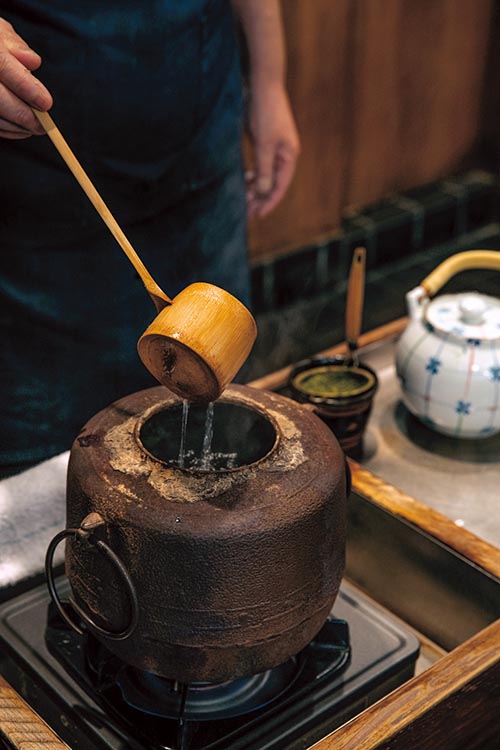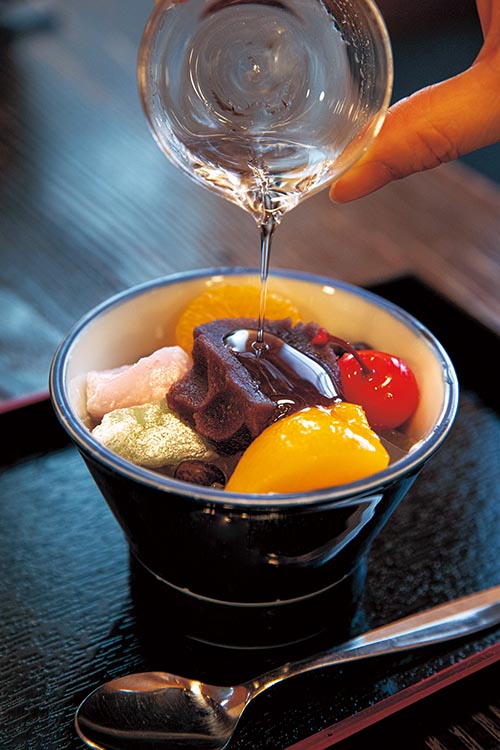
2021 NO.31
Menu
 Tasty Japan: Time to Eat!
Tasty Japan: Time to Eat!

Kanmidokoro
Savor a Quick Break
with a Retro Vibe
Photos: Arai Akiko
The interior (left) and exterior (top right) of the serene and elegant Hatsune sweets shop. The dark stained wood tells the story of time passing. Bottom right: Deliciously mild tea is brewed with water boiled in an iron teakettle.
In cities across Japan, you can find kanmidokoro (literally meaning “sweet taste place”) which, as the name suggests, are cafes specializing in sweet treats. Thought to have emerged in the late Edo period, around the start of the 19th century, these cafes boast a longer history than Japan’s kissaten tearooms that double as coffee shops. In contrast to kissaten menus, which mainly feature coffee, cakes, sandwiches and other items from the West, kanmidokoro are devoted to serving traditional Japanese confections. Some even offer light savory snacks, as well. Decorated inside and out with wood and bamboo, these shops take you back in time to the streets of old Japan.
The essential ingredient for many of the choices offered on the kanmidokoro menu is adzuki bean paste. This sweet bean jam, made by boiling adzuki beans in water and sugar, comes in two varieties: koshi-an, which is strained to remove the skins, and tsubu-an, which is made with the skins left in.
Sweet shiruko soup is made from adzuki paste and served with grilled mochi rice cake, filling enough for a meal. Diners looking for a light, refreshing dessert opt for mitsumame, a combination of red peas and agar made from a type of seaweed called tengusa, topped with plenty of white or brown sugar syrup. In 1930, a kanmidokoro in Ginza topped mitsumame with a scoop of adzuki paste in a sundae-like confection that it called anmitsu. To this day, anmitsu continues to be one of the most popular items served at kanmidokoro.
Anmitsu
Left: Adzuki bean paste, gyuhi (mochi made from rice flour and maltose syrup), and fruit served in a colorful presentation. Drizzle with white or brown sugar syrup and enjoy!
Right: Hidden among the rest are agar and red peas. Glossy agar is the standout star of anmitsu.
Most of these sweet confections are difficult to prepare in advance. Shiratama, small white balls of glutinous rice flour dough, lose their firm texture if left soaking for too long after being boiled. Agar gets soggy soon after it is cut into cubes. To serve with just the right texture, shiratama and agar are made after the customer orders. It is the chewy, smooth shiratama and agar paired with sugary syrup and richly sweet adzuki paste that delights the senses. Relaxing with one of these special dishes is simply the best!
Hatsune, established in 1837, is a kanmidokoro in Tokyo’s Ningyo-cho neighborhood. According to eighth-generation owner Ishiyama Miyuki, most of the oldest kanmidokoro are located in monzen-machi towns that grew up around influential temples or shrines.
“Long ago in Japan, restaurants in town were frequented only by men. At that time, kanmidokoro were really the only place where women and children could sit down to enjoy a comfortable time having a bite to eat. After a visit to a shrine or temple, women and children loved stopping by these sweet shops.”
Kanmidokoro are precious spots for enjoying traditional handmade sweets and a nostalgic atmosphere. Today they welcome everyone, men and women, young and old—anyone with a sweet tooth.
Zoni
Zoni, a broth-based soup with mochi and other ingredients, is not only an essential part of Japanese New Year’s celebrations, but an everyday dish, as well. Many kanmidokoro include zoni on their menu as a light snack. Pictured above is the Egg Zoni served at Hatsune, featuring beaten egg, seaweed, and Japanese parsley.









